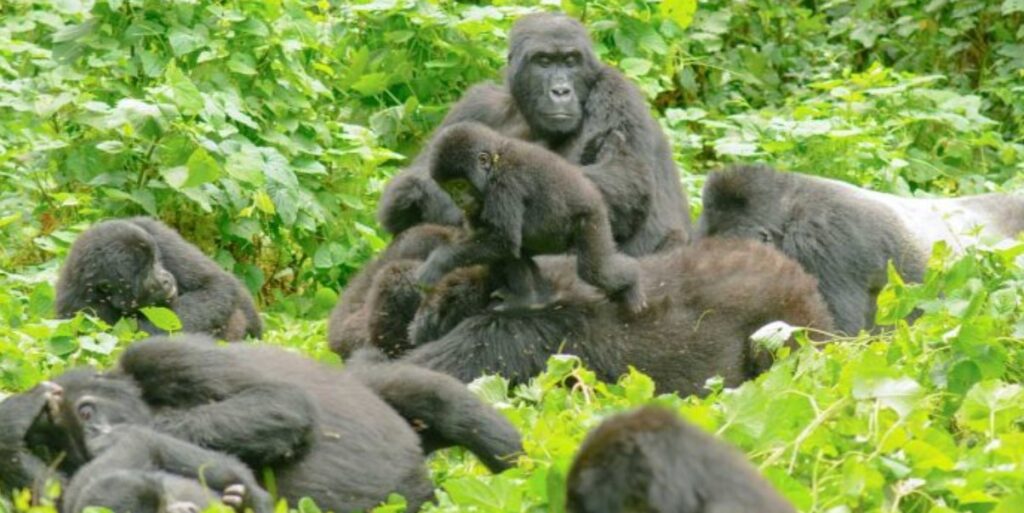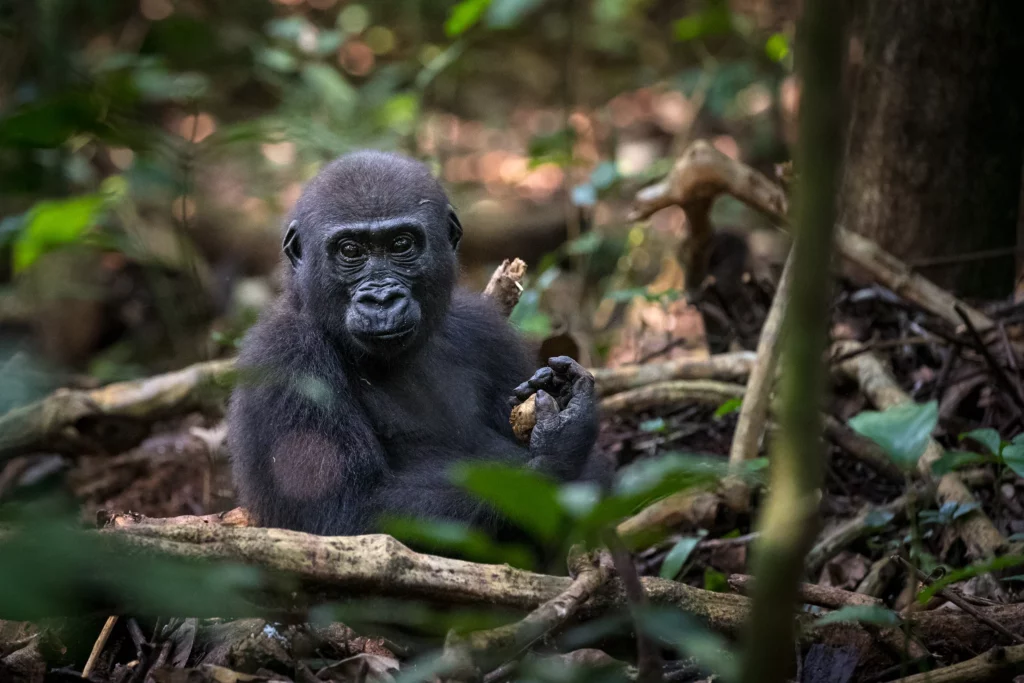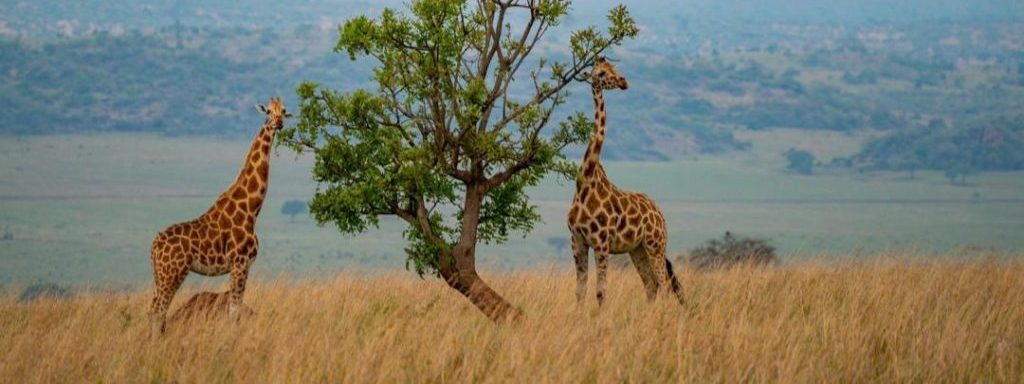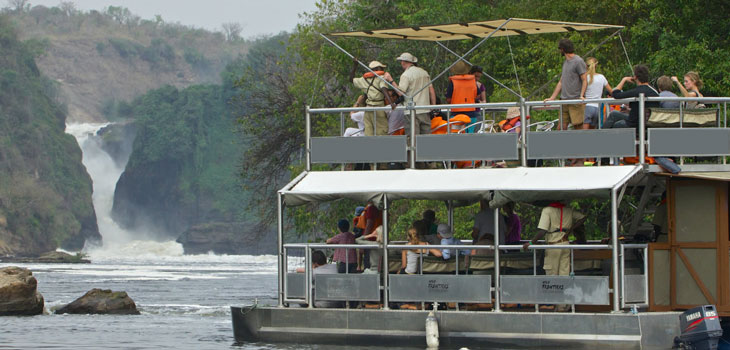
Gorilla trekking in Africa
Gorilla trekking in Africa
Gorilla trekking in Africa is the way that involves the gorilla trekkers to go on a guided hike and walk with the presence of well experienced guides and armed rangers through dense African rainforest while looking for the gorillas, as this takes a period of thirty minutes to 6 hours while searching for the gorillas, the gorillas keep moving deep in the forests while looking for the food. But once the gorillas are found the gorilla trekkers are given one hour to be in the presence of the gorillas in their habitants, while observing their characters, watching them play, feed, groom, taking their pictures, recording their videos to take and show people at home after a gorilla trekking safari.
Numerous brave travelers rank seeing gorillas in Africa as one of the top 50 safari experiences to have before you die. Yes, exactly. And Africa brings you the magical safari destinations that experiences you with the stunning gorilla trekking.
Bwindi Impenetrable National Park and Mgahinga Gorilla national park, in the highlands of southern Uganda, and Volcanoes National Park, in the northwestern corner of Rwanda on the slopes of the Virunga Mountains, and Virunga national park in Democratic Republic of Congo are three of the best places in Africa to see mountain gorillas. Some of the best rainforest retreats in Africa’s most isolated regions can be found in these two countries, which also provide some of the continent’s best gorilla trekking safari and top-notch infrastructure.

The eastern gorilla is endemic to the Democratic Republic of the Congo (DRC) in Kahuzi Beiga national park. Nigeria, Cameroon, the Central African Republic, Equatorial Guinea, Gabon, the Republic of the Congo, Angola, and the Democratic Republic of the Congo are also home to western gorillas. Uganda, Rwanda, the Democratic Republic of the Congo, the Republic of the Congo, and the Central African Republic (CAR) are the top five African countries for gorilla trekking safaris. The tourist infrastructure in these areas is perfect for gorilla safaris.
Honestly, exploring the wild forests of Africa in search of the planet’s largest living primates is something to fill your mind with, tuck away safari experience, and brag about to your friends. Feel free to examine the notion in silence for a while.
If you’re wondering why all the hubbub, read on as we delve into the fascinating history of the wild’s most imposing inhabitants. Unlike Hollywood’s King Kong, gorillas are docile big primates. They share many traits and feelings with humans, including humour and pathos.
Gorillas are our closest living relative, sharing 98 percent of our genetic code with human beings. They have thick, hairless bodies, huge hands that resemble those of humans, and tiny eyes. They form extended families of five to thirty or more members, much like early humans, and are headed by a dominant adult male known as a silverback. A gorilla’s social life revolves around the relationship between the silverback and his females.
Where do gorillas live?
Gorillas are endemic to Africa and can only be found in the continent’s tropical rain forests. Both the Virunga mountain gorillas of Rwanda, Uganda, and the Democratic Republic of the Congo and the Bwindi gorillas of Uganda can be found in the rift valley Mountains of East-Central Africa. The tropical forests of Equatorial Guinea, Angola, Cameroon, the Central African Republic, the Congo, Gabon, and the Democratic Republic of the Congo are home to the critically endangered lowland gorilla.
Governments, conservation groups, and wildlife experts have all put in a lot of effort to keep gorillas safe in their natural environments. Out of the many wild gorilla family groups that wander Africa’s tropical woods, scientists have habituated a few groups for tourism. That means people can go observe them in their natural habitat without worrying about harming them, and in the process, help preserve them. Now that you’re well-schooled for your next summer adventures, let’s take a look at the five great safari destinations that offer the best adventures to see gorillas in Africa.
- Uganda.
Uganda’s two mountain jungles are without a doubt the best places in Africa to go on safari to view wild mountain gorillas. Both Bwindi Impenetrable National Park and Mgahinga National Park, which together with Rwanda’s Volcanoes National Park and the Democratic Republic of the Congo’s Virunga National Park, zealously preserve nearly half of the world’s remaining mountain gorillas. More than half of the world’s mountain gorilla population is protected in these two parks, making Uganda a prime location for viewing these primates in their natural habitat.
About 491 kilometres (305 miles) from Uganda’s capital city, on a road that is 90% paved, are two gorilla habitats. The gorilla habitats are a nine to ten-hour car ride or a short, local flight away.
Those who choose to escape the bone-jarring drive through the rocky Nepal-like scenery can easily access the north and south sections of Bwindi Impenetrable National Park through two small airfields located two hours outside of each region. A trip through the classic landscapes of southwestern Uganda in search of the wild gorillas is well worth it if you have driven through Nepal or heard about it in discussion.

Mountain gorillas in the wild form large family units that humans refer to as troops or bands. An unknown number of soldiers make their home in the remote woods, out of harm’s path. However, the Uganda Wildlife Authority has habituated 23 gorilla families and made them available for tourism with the support of scientists and wildlife professionals. Any traveler can begin their gorilla trekking safari experience in Uganda at one of five different locations and encounter one of the 23 gorilla groups that have become accustomed to human visitors. A gorilla permit can be purchased from UWA for roughly $700 per person.
Gorilla trekking in Bwindi Impenetrable forest national park takes place in four different sectors that is Buhoma in the north, Ruhija in the east and then Nkuringo and Rushaga in the southern park. The standard gorilla permit lasts for an hour and costs $700, but the four-hour gorilla habituation experience permit, available exclusively in the Rushaga area, costs $1,500. Only in Uganda can you spend four hours in the company of wild gorillas.
Mgahinga National Park, which is located on the same Virunga slopes as the gorilla parks in Rwanda and the Democratic Republic of the Congo, is home to one family of habituated gorillas. In particular, those who like to combine their gorilla visit with a walk to one of the Virunga peaks and a look at the region’s endangered golden monkeys (found nowhere else on the planet).
Any area of a gorilla park will provide the same exciting safari opportunity for a gorilla encounter. Every morning, a team of expert trackers and rangers leads groups of up to eight tourists to a family of mountain gorillas. Finding the wild gorilla family could take anywhere from half an hour to six hours. After finding the wild giants, the rangers will let the tourists spend at least an hour within 7 metres of them while wearing face masks and following tight orders not to approach or touch the animals.
After your amazing travels in Uganda to witness Africa’s wild gorillas, continue your wildlife watching by visiting the northern safari circuit, the western safari circuit. It’s a good idea to include a safari in Uganda on your way to see the mountain gorillas.
A few kilometres north of Bwindi, at Queen Elizabeth National Park, you can see tree-climbing lions, pods of hippos, herds of elephants, buffalo, and crocodiles sunning themselves on the banks of the Kazinga Channel. Kibale Forest is a home to a dozen different species of primates, including our human-adapted chimpanzee relatives. Some of Africa’s most fantastic animals are free to roam the plains of Murchison and Kidepo Valley, farther north.
- Rwanda.
The majestic Virunga Mountains, located in the country’s extreme northwest, have made Rwanda a popular choice as an African adventure travel safari destination. Rwanda’s Volcanoes National Park shelters the world’s most endangered primates, the mountain gorillas, in the country’s stunning Virunga Mountains.
The second-best safari experiences in Africa for seeing gorillas, after trekking in Uganda, are in Rwanda, in the Virunga Mountains where nearly half the world’s population seeks safety. Three countries Uganda, the Democratic Republic of the Congo, and Rwanda share the Virunga Mountains. Volcanoes National Park safeguards the Rwandan portion of the Virunga, and it is home to ten (10) family groups of gorillas that have become accustomed to human visitors.
You can spend the night at Kiningi, a little village spread out at the foothills of the gorilla park, after driving northwest from Kigali, the capital city, for around two hours on a well-surfaced road. You may discover a wide range of vacation lodges, from cheap bed-and-breakfasts to luxurious cabins in the woods, to suit your needs and your wallet.

Be at the park headquarters by 07:00 am for a briefing before specialist trackers guide small groups of about eight visitors into the sweltering jungles in search of the habituated gorilla group, depending on where you spend the night. With the help of your knowledgeable guide and a voiceover, you’ll spend at least an hour observing the wild silverback patriarch and his family.
Tourists who want to see wild gorillas in Africa but don’t want to go a long distance often choose to visit Rwanda. Although gorilla trekking safari is possible in both Rwanda and Uganda, only the financially secure can pay Rwanda’s gorilla permit (which costs $1500).
Tourists visiting Rwanda can do a lot more than just go on a primate safari in the Virungas; the country offers a rich cultural experience as well. Hiking the Virungas, seeing Dian Fossey’s Karisoke Centre, trekking habituated chimps in Nyungwe Forest, and sighting the big five animals in Akagera National Park are all part of a standard Rwanda safari package.
- The Democratic Republic of Congo.
Due to its ongoing civil battles along its borders with Rwanda and Uganda, the Democratic Republic of the Congo is not a popular safari destination for tourists hoping to see gorillas in Africa because of the political instabilities though now security has been implemented which has made Congo as well to receive tourists to carry out gorilla trekking safari. However, if you have the chance for it, the DRC is one of the greatest places to visit gorillas in Africa since it is shamelessly wild, more adventurous, and cheaper than Uganda and Rwanda.
Democratic Republic of the Congo (DRC) is the only country in the world that is home to all two kinds of gorillas (mountain gorillas, eastern lowland). Assuming you can figure out the logistics, your best bet for seeing wild gorillas in Africa is the Democratic Republic of the Congo, where your chances of seeing all the gorilla types is high.

Some western lowland gorillas go back and forth from Cabinda (Angola) to the lush Mayumbe Area, Bas-Congo, in the far west of the DRC. Dzanga-Ndoki National Park in the Central African Republic, Nouabalé-Ndoki National Park in the Republic of the Congo, Lopé National Park in Gabon, and Monte Alen National Park in Equatorial Guinea are the best places to see western lowland gorillas without risking your life in the far eastern DRC.
To the southwest of the Virunga Volcanoes is where you’ll find the other gorilla species in DRC: the eastern lowland gorillas (also known as Grauer’s gorilla). Unlike their mountainous counterparts, they prefer to spend much of their time under the canopy. Kahuzi-Biega National Park is the primary habitat for eastern lowland gorillas, and it is there that you will have the most successful encounters with gorillas that have become accustomed to humans. You may reach Kahuzi-Biega from the town of Bukavu, located just south of the Rwandan border. However, before travelling there from Rwanda, you should thoroughly research the current security situation.
Virunga National Park in the Democratic Republic of the Congo (DRC) is a great place to see mountain gorillas in their natural habitat. Access to Virunga National area has been greatly expanded thanks to the area’s increased safety; visitors can now enter the park through Kisoro in Uganda or fly in from Goma, a town on the northern shore of Lake Kivu.
The eight (8) family groups of human-habituated gorillas in Virunga National Park are trekked by small groups of tourists led up into the mountain forests by trained trackers and armed rangers, much as they do in Uganda and Rwanda. Tourists spend at least an hour away from the wild giants, seven metres away, wearing facemasks.
Visiting Virunga National Park in the Democratic Republic of the Congo is on the itineraries of many seasoned explorers this summer. For example, the Oscar-nominated Netflix smash “Virunga” tells the true story of the rangers who risked their lives to defend Africa’s most valuable national park and its endangered mountain gorillas.
Vacation rentals in Virunga are not as large as those in Bwindi or Rwanda’s Volcanoes, but they are nonetheless comfortable and convenient. Visit the recently erected Kibumba tented camp, the starting point for gorilla trekking safaris in Virunga, the opulent Mikeno Lodge, or the simple serenity of Tchegera Island.
- The Republic of the Congo.
Republic of the Congo (also known as Congo-Brazzaville), a peaceful republic in central Africa bordered by Gabon, Cameroon, Central African Republic, and Democratic Republic of the Congo, is a great place to watch western lowland gorillas.
About 125,000 western lowland gorillas, as well as chimpanzees, forest elephants, and hundreds of species of birds, can be found in the Congo’s mainly undiscovered rainforest reserves.
Trekking and viewing western lowland gorillas is made easier in Odzala-Kokoua National Park, located in the northwest of Congo. After the tragic spread of the Ebola crisis, the park reopened in 2012. The deep jungle is home to two families of gorillas that have become accustomed to human visitors. Swamps, with their abundance of salty minerals, water, and delicious grass, are the finest places to encounter these wild apes.
Three to four visitors, a seasoned trekker, and a local guide make up an average gorilla trekking safari expedition in Odzala. Ngaga Camp and Sangha Lodge are the best places to stay in Odzala-Kokoua National Park, and every morning a few of visitors set out on foot to spend an hour with the park’s famous gorillas.
The famed Mbeli Bai can be found in the unspoiled African wilderness of Nouabalé-Ndoki National Park in the north of the Congo, which shares its borders with Cameroon’s Parc national de Lobék and Central African Republic’s Dzanga-Sangha National Park. The park is home to a wide variety of wildlife, including the world’s largest population of forest elephants and an estimated 100 western lowland gorillas. In Dzanga-Sangha, you can undoubtedly have one-of-a-kind wildlife encounters. Groups of gorillas, as well as forest elephants, buffalo, and antelope like the sitatunga, have been spotted foraging for water plants in the marsh.
The most comfortable and reasonably priced camping options in the area are found at Mbeli Camp and Mondika Camp. Visitors may see the gigantic silverbacks in their natural habitat on a forested island, and it’s amazing. Visitors can also visit the Léfini Reserve (two hours north of Brazzaville) to see orphaned western lowland gorillas being reintroduced to the wild.
- The Central African Republic (CAR).
Not everyone should attempt to explore the wilds of the Central African Republic. Finding wildlife can be difficult, but experiences in this area of the African rainforest are among the most exciting and rewarding safari you’ll have anywhere in Africa. There are more western lowland gorillas and forest elephants here than anywhere else in the world.

Two of the three human-habituated western lowland gorillas are located in Dzanga-Sangha National Park in southern CAR. Another is located in the Democratic Republic of the Congo.
A safari to the rainforests of the remote Dzanga Sangha Reserve, track endangered western lowland gorillas, observe forest elephants, bongos, and mangabey monkeys, and join the local Ba’Aka tribe on a net hunt in the jungle dense rainforests.







